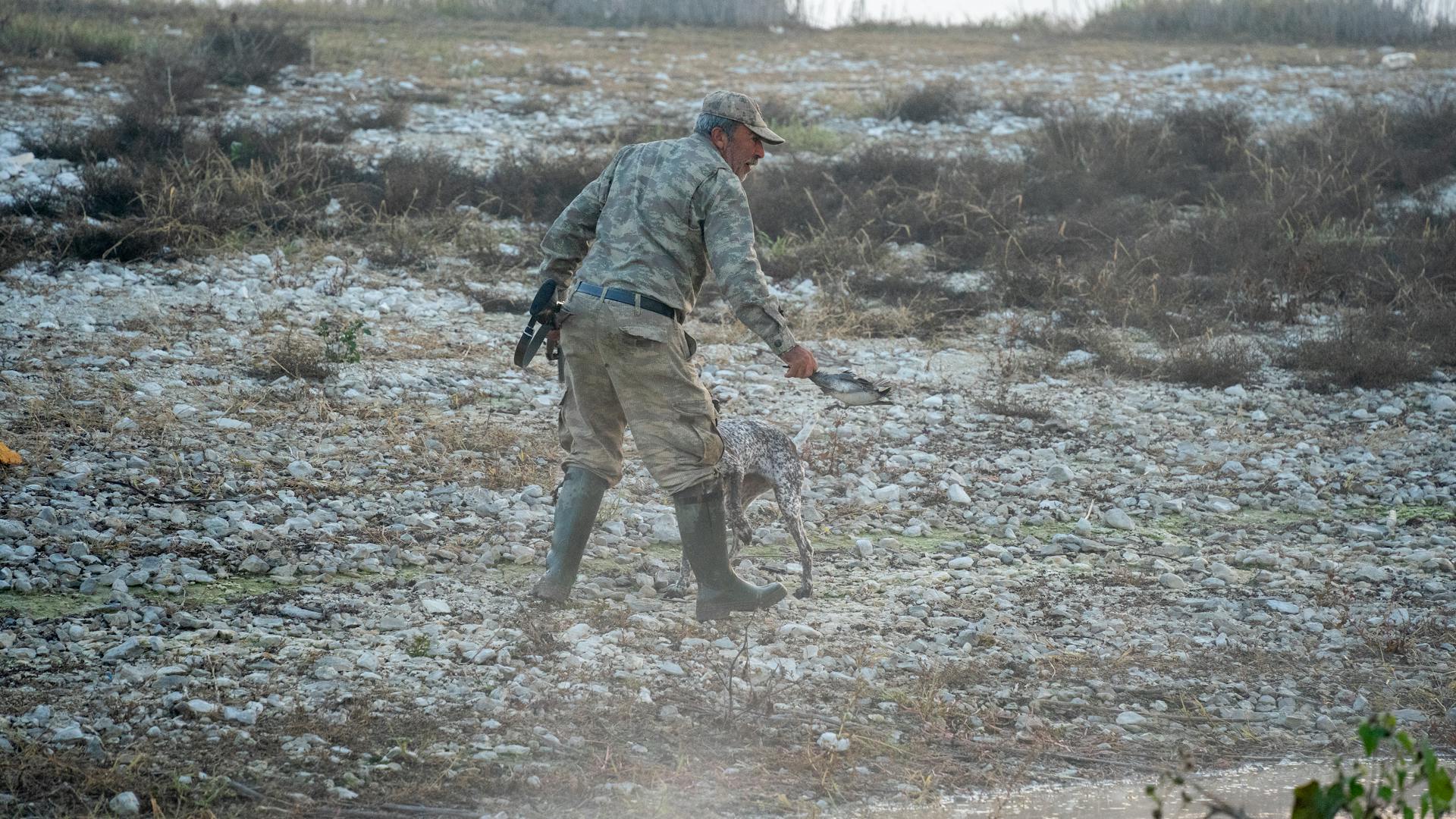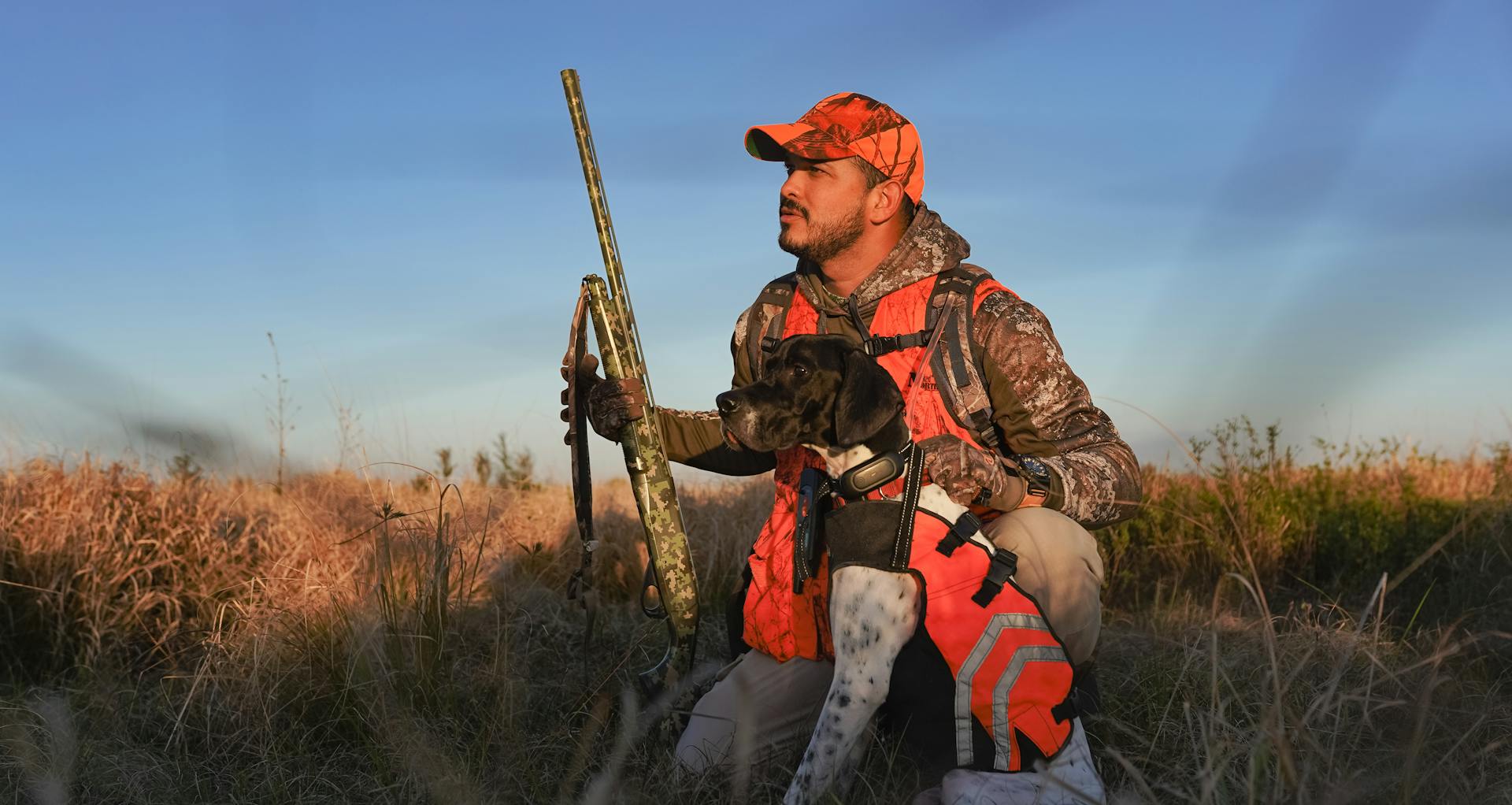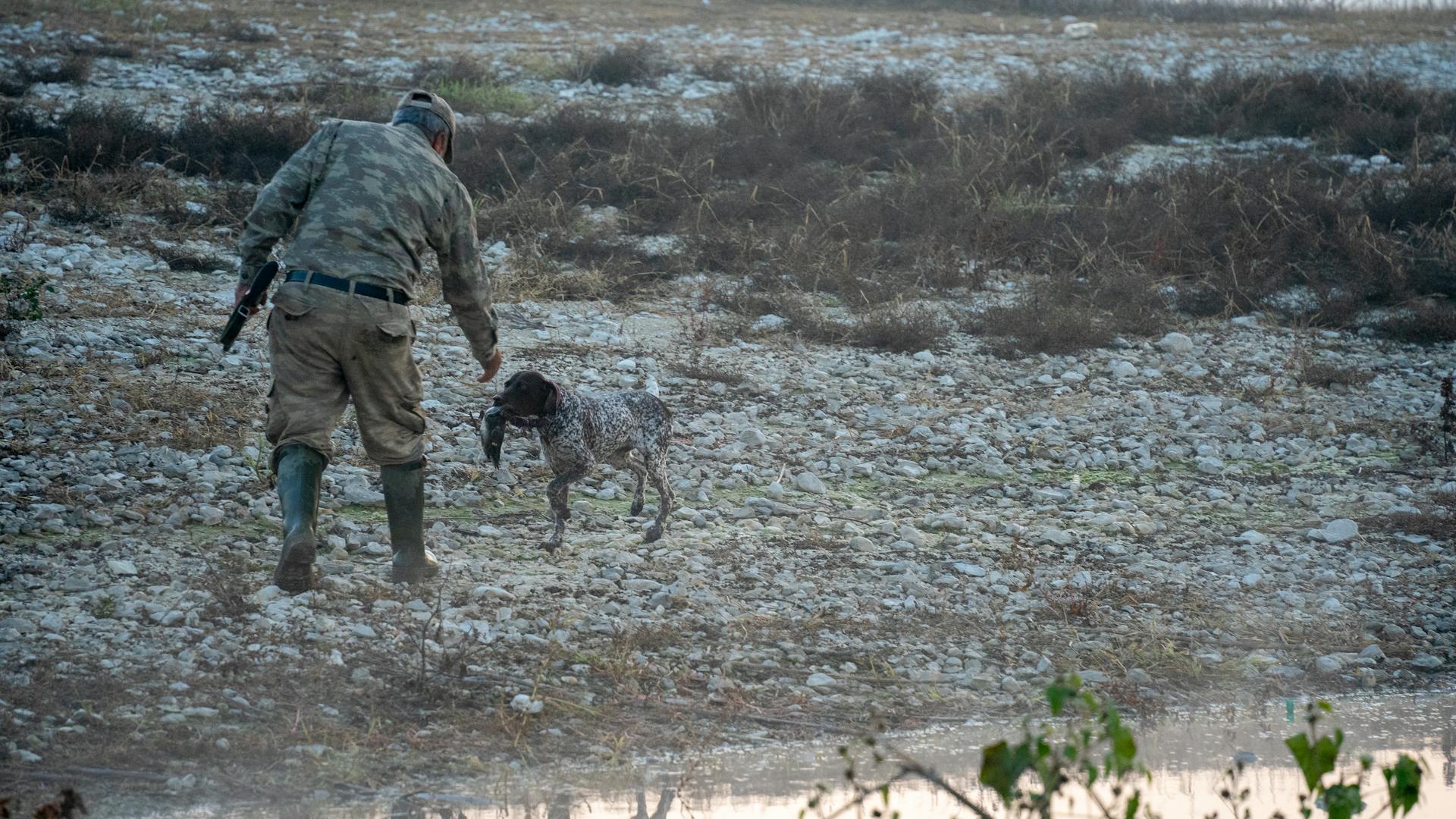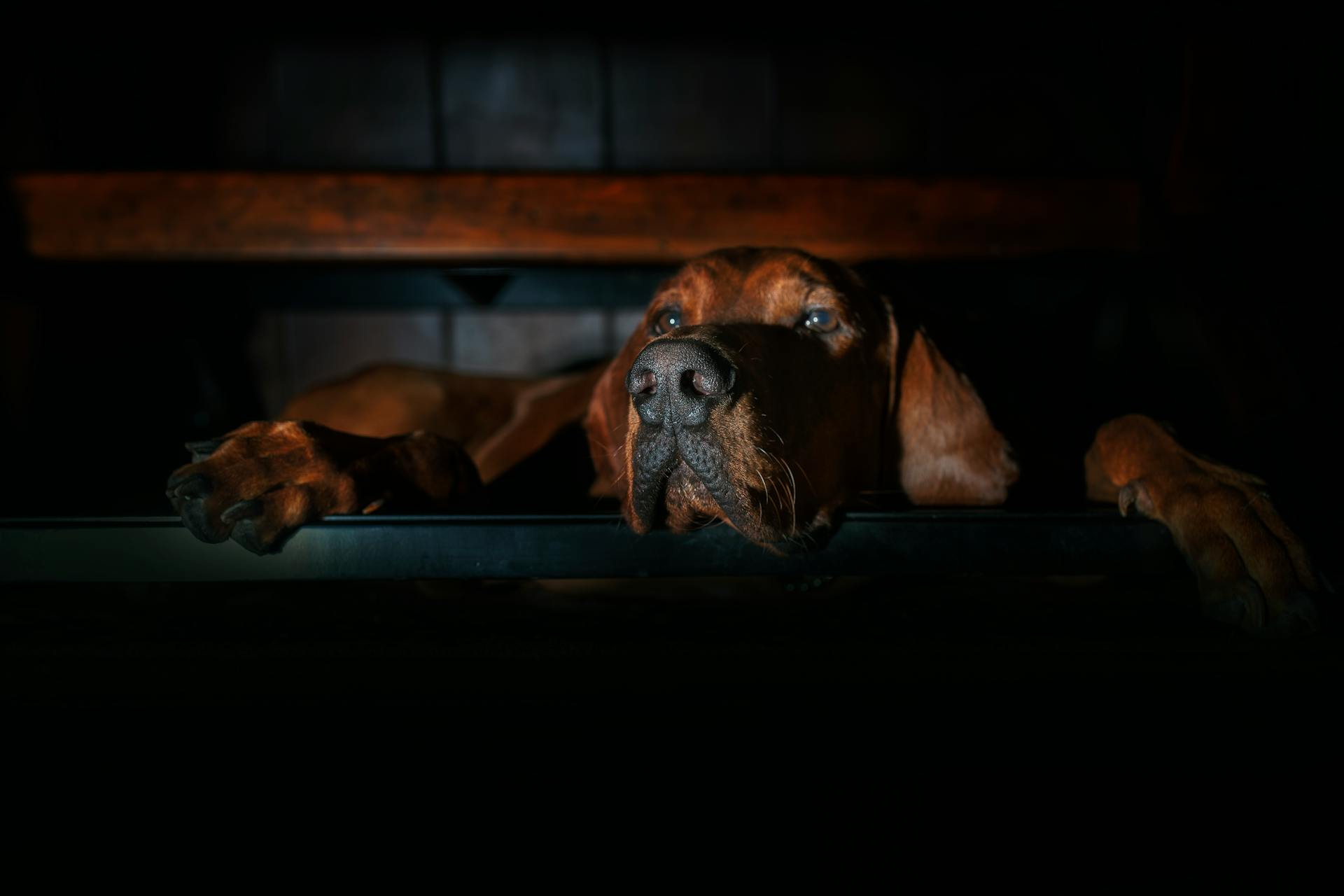
The Redbone Coonhound is a breed with a rich history that dates back to the early 19th century in the United States.
Developed from the English Foxhound, the Redbone Coonhound was specifically bred for its exceptional tracking abilities, which made it a valuable asset for hunting small and large game.
This breed's strong work ethic and athletic ability allowed it to thrive in the rugged terrain of the American South, where it became a staple in many hunting families.
With its distinctive reddish-brown coat and athletic build, the Redbone Coonhound is an unmistakable sight on a hunting trail.
Breed Characteristics
The Redbone Coonhound is an energetic hunting dog with a short attention span, but they can be laid back when not working, allowing a goofy yet soulful personality to shine through.
Their high affection level and friendliness make them a great addition to many families, and their kid-friendly nature means they're a great choice for families with children.
Additional reading: Great Pyrenees Hunting Dog
Redbone Coonhounds are scent hounds, so they will sniff everything with great concentration and intensity. They're also known to have a high tendency to bark, which can be a consideration for city dwellers or those who value a quiet home.
Here's a quick rundown of their key characteristics:
One thing to note is that Redbone Coonhounds are relatively low shedders, which is great news for those with allergies or who prefer a cleaner home.
Dog Care
Redbone Coonhounds are relatively easy to care for, but they still need regular brushing to stay happy and healthy.
They have short, smooth coats with a low rate of shedding, so weekly brushing is all they need to look their best.
Regular bathing can help reduce their distinctive musky hound odor.
Cleaning their ears regularly is crucial to prevent infection, especially since they have long floppy ears.
Trimming their nails regularly will prevent splitting and tears.
Brushing their teeth daily is essential to maintain dental hygiene and prevent periodontal disease and oral infections.
Redbone Coonhounds are generally friendly to everyone and make great family dogs when properly trained.
Suggestion: Dogo Argentino Natural Ears
Training
Training your Redbone Coonhound is a must to channel their natural instincts in the right direction. They're intelligent dogs who are eager to please, but can get easily distracted by interesting scents.
Basic obedience training is a great place to start, teaching your puppy commands like sit, stay, and come. Leash training is also crucial to prevent them from taking off after a squirrel, which can be tough on your shoulder.
Keep training sessions short, around 10 minutes, and reward your pup with treats, praise, and playtime with special toys when they do a good job. A confident and calm leader is key to successful training, as Redbone Coonhounds can get frustrated if they're not patient.
Redbones need plenty of exercise to prevent barking and digging, so leashed walks and a fenced yard are essential. Microchip your dog and make sure they're wearing up-to-date ID tags to prevent wandering.
Positive reinforcement training methods are a great way to train your Redbone Coonhound, especially when they're young. They respond well to patience and persistence, but can be stubborn at times.
Proper training is an absolute necessity for Redbones, and it's best to use positive reinforcement methods. They need lots of patience and persistence, and may creatively interpret your instructions rather than follow them as intended.
A unique perspective: When Should You Mate a Female Dog
Health and Nutrition
Redbone Coonhounds require a well-balanced diet that includes ample protein, carbohydrates, and healthy fats, which can be met with high-quality commercial dog food formulated for active breeds.
Choose a high-quality diet that meets the nutritional standards set by the Association of American Feed Control Officials (AAFCO). This will ensure your Redbone Coonhound is getting the right nutrients to stay healthy and active.
Redbone Coonhounds are prone to overeating, so be sure to monitor your pet's weight to avoid obesity, which can shorten a dog's lifespan and put them at risk for other conditions.
For more insights, see: Dog with High Prey Drive
Hound Nutrition
Redbone Coonhounds require a well-balanced diet that includes ample protein, carbohydrates, and healthy fats.
Feeding your Redbone Coonhound twice a day is a good rule of thumb, rather than one large meal or allowing free feeding. This will help prevent overeating and obesity.
A high-quality commercial dog food formulated for active breeds and meeting the nutritional standards set by the AAFCO is a good choice. Your veterinarian can help you choose the best food for your pet.
Redbone Coonhounds are known to be enthusiastic eaters and are prone to overeating, so monitoring their weight is crucial. Obesity can shorten a dog's lifespan and put them at risk for other conditions.
Adult Redbone Coonhounds typically consume about 2-2.5 cups of high-quality dry dog food per day, though this can vary depending on their age, size, health, and activity level. Your AAFCO-approved dog food will provide portion guidance on the packaging.
Puppies need to eat more frequently, about three or four meals a day on a regular schedule.
Explore further: When Is National Boston Terrier Day
Health Issues
Redbone Coonhounds are generally healthy dogs, but like all breeds, they can be prone to certain health issues. Their average lifespan is 12-15 years, which is a good indicator of their overall health.
Hip and elbow dysplasia are two common health problems that can affect Redbone Coonhounds. This condition occurs when the joint is malformed and rubs, causing the dog pain, which can be managed with dietary and lifestyle changes, or in severe cases, surgery.

Redbone Coonhound puppies should be fed large-breed puppy food to help prevent bone and joint problems like panosteitis, an inflammation of the bone that causes pain and lameness. This can be treated with medications, including anti-inflammatory drugs, and limited activity to minimize pain.
Coonhound paralysis is an immune reaction to raccoon saliva that inflames the dog's nerves, affecting their gait and breathing. If you suspect your pup has contracted coonhound paralysis, take them to the vet immediately.
Progressive Retinal Atrophy (PRA) causes gradual vision loss, with night blindness often being an early symptom. While there's no cure for PRA, most dogs adapt well to vision loss.
Here are some common health issues to watch out for in Redbone Coonhounds:
- Hip dysplasia
- Ear infections (otitis)
- Hip and elbow dysplasia
- Panosteitis
- Coonhound paralysis
- Progressive Retinal Atrophy (PRA)
Exercise
Redbone Coonhounds need at least an hour or two of exercise every day to stay happy and healthy. They're bred to run, not walk, so daily runs or long walks are a must.
If you enjoy running, take your Redbone with you and get some exercise together. They love to speed around the yard and can get very frustrated if they don't have an outlet for their energy.
Redbone Coonhounds are great at dog sports like agility and tracking, so consider enrolling them in a class or activity. This will not only tire them out but also provide mental stimulation.
Never let your Redbone off-leash outside of an enclosed area, like a fenced backyard. They have a strong desire to hunt and can catch a scent and be off in a flash.
A spacious, fenced-in yard is a must for Redbone Coonhounds. They need to be able to run freely and safely, so a physical fence is essential.
Redbone Coonhounds are excellent swimmers, so consider taking them for a swim as part of their exercise routine. This will help them get some exercise and have fun.
With their high energy levels, Redbone Coonhounds can easily become bored if they don't get enough exercise. Aim for at least 90 minutes of exercise per day to keep them happy and stimulated.
History and Adoption
The Redbone Coonhound has a rich history that spans centuries. They originated from red foxhounds brought to the United States by Scottish immigrants in the late 18th century.
Their ancestors were bred to hunt raccoons and foxes in Tennessee and Georgia, where they became skilled at treeing raccoons. The Redbone Coonhound was officially recognized by the American Kennel Club (AKC) in 2009.
If you're interested in bringing a Redbone Coonhound into your life, you can find reputable breeders on the AKC's website or reach out to Redbone Coonhound rescue organizations to adopt one.
Here are some organizations that can help you find a Redbone Coonhound:
- American Redbone Coonhound Association
- National Redbone Coonhound Association
- Coonhound Rescue
The average price for a Redbone Coonhound puppy is between $800 to $1,500, and you can also expect to spend money on regular grooming to control their distinctive hound odor.
Dogs in Where the Red Fern Grows
The Redbone Coonhounds in Where the Red Fern Grows are truly iconic.

Wilson Rawls' classic book features the breed as the main hunting companions for the protagonist, Billy Coleman. The United Kennel Club accepted the Redbone Coonhound breed in 1902.
The Redbone Coonhound has a lean, athletic body that is well-proportioned, with long straight legs and a deep belly. They have a characteristic coonhound subgroup body shape.
Their coats are short and sleek, but coarse enough to cover the skin when hunting in dense underbrush. Redbone Coonhounds require weekly brushing for optimal health.
The breed's big paws have thick pads and webbed toes, making them well-suited for hunting in various terrains. Dewclaws are a popular feature in this breed.
The Redbone Coonhound's nose is always black and prominent, with black on the muzzle and around the eyes, a practice known as masking.
History of the
The Redbone Coonhound has a rich history that dates back to the late 18th century when Scottish immigrants brought red foxhounds to the Southeastern United States.

These early foxhounds were the foundation of the breed, and over time, they were bred for raccoon-hunting traits, resulting in the Redbone Coonhound we know today.
The breed's development took place primarily in Georgia, where they were crossed with Irish hounds and possibly bloodhounds.
The Redbone Coonhound's distinctive red coat is a result of breeding, as the original coat featured a black saddleback streak.
By the end of the 19th century, the Redbone Coonhound was a well-established breed.
The United Kennel Club accepted the breed in 1902, but it wasn't until 2009 that the American Kennel Club recognized the Redbone Coonhound.
The breed's history is also tied to literature, as the classic book "Where the Red Fern Grows" features Redbone Coonhounds as the main hunting dogs.
The Redbone Coonhound has a long history of being a skilled hunter, capable of treeing raccoons and other small animals.
Their athletic ability and bravery have made them a popular choice for hunters and farmers.
The breed's physical characteristics, including their lean body, long straight legs, and deep belly, are characteristic of the coonhound subgroup.
Their short, sleek coats require weekly brushing to stay healthy, and their big paws have thick pads and webbed toes.
Discover more: United Kennel Club American Bully
Adopt or Buy
If you're considering bringing a Redbone Coonhound into your life, think about whether you can provide enough exercise and regular baths to control that hound odor. They can be a handful, but they're worth it!
Before searching for a Redbone, consider whether you have other small animals in your home and if you can handle the loud baying and howling. These dogs are not for the faint of heart!
You can start by reaching out to an advocacy organization, such as the American Redbone Coonhound Association, the National Redbone Coonhound Association, or Coonhound Rescue. They may be able to pair you with a reputable breeder or rescue in your local area.
If you're unsure whether the breed is right for you, you may be able to foster a dog to see if a Redbone coonhound fits into your home and lifestyle.
Here are some things to keep in mind:
- Challenging to train for long periods
- Loud baying and howling
- May have a musty doggy odor
Frequently Asked Questions
What do Coonhounds hunt for?
Coonhounds are bred to hunt a variety of wildlife, including raccoons, feral pigs, bobcats, cougars, and bears. They are skilled scenthounds designed for tracking and flushing out these elusive game species.
What is the best coon hunting dog?
According to experienced coon hunters, the Treeing Walker is often considered the best breed for coon hunting, known for their hard-hunting ability and speed.
What are the drawbacks of having a Redbone Coonhound?
Redbone Coonhounds may be prone to hip dysplasia and ear infections, and are at risk of injuries while hunting due to their active nature and potential encounters with wildlife
Featured Images: pexels.com

